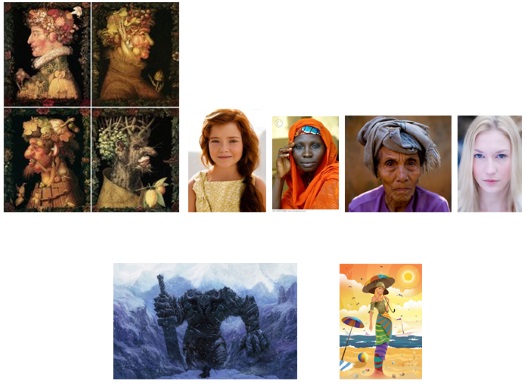Editorial
The activities below were developed during a Pilgrims Teacher Training Course 2017: 21st Century Thinking Skills (tutor Hania Kryszewska). The atrting point were paintings by Archimboldo – The Four Seasons http://www.oilpainting-repro.com/im/articles/Arcimboldo_4saisons.jpg
21st Century Thinking Skills with Archimboldo
Lucia Olosová and Juli Károlyi, Andrea Winter and Lilja Gudmundsdottir, at Pilgrims 2017
Menu
Arcimboldo: The Four Seasons by Lucia Olosová and Juli Károlyi
Arcimboldo: The Four Seasons by Andrea Winter and Lilja Gudmundsdottir
Lesson plan for B2+ level group aged 14-18 divisible into 4 teams of 3-5 students
Teaching focus: revision of adjectives describing character, revision of can/can’t/be able to, encouraging innovation and lateral thinking through art, IT skills in action, teamwork and collaboration, creative process, presentation and listening skills
- The teacher divides the group into four teams of 3-5 students and hands out one of the laminated repros of Arcimboldo’s Four Seasons to each team, without telling them that each portrait represents a season. Their task is to come up with 3-5 adjectives to describe the character of the person in the painting (10 mins)
- The portraits are handed around until each team has added their own 3-5 character adjectives (with or without seeing what the others had written, it’s up to the teacher). (10 mins)
- When each team has got back their original portrait, the teacher reveals/elicits that they are, in fact, meant to represent one of the seasons. Then the teams are asked to find a real-life portrait on Google (using their smartphones) that, in their opinion, could represent the same season. Team members should all agree on this and be able to justify their choice. (10 mins)
- The portraits are handed around (not the full circle, just one or two steps) and the task is again to assign 3-5 five adjectives describing the person’s possible character. Teams report back to the whole group and the differences of opinion are briefly discussed. The teacher is to stress that this kind of judging a book by its cover is just guesswork and should be avoided in real life. (15 mins)
- The teacher writes the word SUPERHEROES on the board and invites the group to brainstorm the names of superheroes. When they have collected a fair few names, the teacher circles four of them and re-divides the group into four new teams using the four names as labels (so instead of ‘1-2-3-4’ it’s ‘Superman-Spiderman-Batman-Captain America’) As a whole group, they briefly discuss what it takes to be a superhero. (15 mins)
- The new teams convene and are randomly given one of the Arcimboldo portraits each. Their task is to design their own superhero, who is the embodiment of the season represented by the portrait. Their description should include: name, appearance, character, superpowers and other special abilities, greatest accomplishments to date. Illustration is not essential but desirable. The descriptions are presented to the whole group and are put on display on the wall of the classroom. (30 mins)

Lesson plan for A2 and above divisible into 4 teams of 3-5 students
Teaching focus: revision of adjectives describing character, encouraging innovation and lateral thinking through art, teamwork and collaboration, creative process
- The teacher divides the group into four teams of 3-5 students and hands out one of the laminated repros of Arcimboldo’s Four Seasons to each team, without telling them that each portrait represents a season. Their task is to come up with 3-5 adjectives to describe the character of the person in the painting (10 mins)
- The portraits are handed around until each team has added their own 3-5-character adjectives (with or without seeing what the others had written, it’s up to the teacher). (10 mins)
- When each team has got back their original portrait, the teacher reveals/elicits that they are, in fact, meant to represent one of the seasons. Their task is now to use the collection of adjectives to create a poem, a Haiku or a diamond.
A diamond is a poem with 11 words and 5 lines:
1. line: one word (adjective, characteristic)
2. line: two words (an object or a person with article)
3. line: three words (how and where is the thing, what is the person doing?)
4. line: four words (something about yourself)
5. line: one word
A Haiku is a poem with 17 syllables:
1. line: 5 syllables
2. line: 7 syllables
3. line: 5 syllables
- The teams write their poems on large posters and present them in class.

Please check the 21st Century thinking Skills course at Pilgrims website.
Please check the Creative Methodology for the Classroom course at Pilgrims website.


|